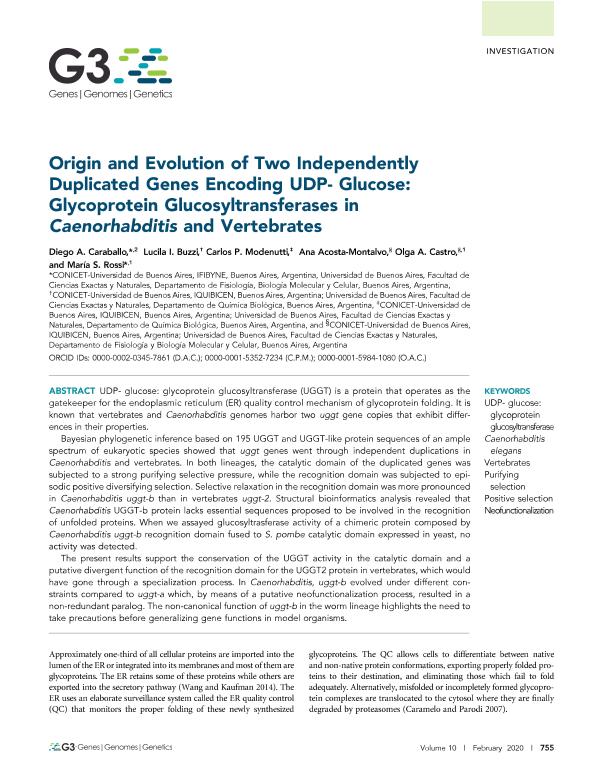Artículo
Origin and Evolution of Two Independently Duplicated Genes Encoding UDP- Glucose: Glycoprotein Glucosyltransferases in Caenorhabditis and Vertebrates
Caraballo, Diego Alfredo ; Buzzi, Lucila Inés
; Buzzi, Lucila Inés ; Acosta Montalvo, Ana Gabriela
; Acosta Montalvo, Ana Gabriela ; Modenutti, Carlos Pablo
; Modenutti, Carlos Pablo ; Castro, Olga Alejandra
; Castro, Olga Alejandra ; Rossi, Maria Susana
; Rossi, Maria Susana
 ; Buzzi, Lucila Inés
; Buzzi, Lucila Inés ; Acosta Montalvo, Ana Gabriela
; Acosta Montalvo, Ana Gabriela ; Modenutti, Carlos Pablo
; Modenutti, Carlos Pablo ; Castro, Olga Alejandra
; Castro, Olga Alejandra ; Rossi, Maria Susana
; Rossi, Maria Susana
Fecha de publicación:
12/2019
Editorial:
Genetics Society of America
Revista:
G3: Genes, Genomes, Genetics
e-ISSN:
2160-1836
Idioma:
Inglés
Tipo de recurso:
Artículo publicado
Clasificación temática:
Resumen
UDP- glucose: glycoprotein glucosyltransferase (UGGT) is a protein that operates as the gatekeeper for the endoplasmic reticulum (ER) quality control mechanism of glycoprotein folding. It is known that vertebrates and Caenorhabditis genomes harbor two uggt gene copies that exhibit differences in their properties.Bayesian phylogenetic inference based on 195 UGGT and UGGT-like protein sequences of an ample spectrum of eukaryotic species showed that uggt genes went through independent duplications in Caenorhabditis and vertebrates. In both lineages, the catalytic domain of the duplicated genes was subjected to a strong purifying selective pressure, while the recognition domain was subjected to episodic positive diversifying selection. Selective relaxation in the recognition domain was more pronounced in Caenorhabditis uggt-b than in vertebrates uggt-2. Structural bioinformatics analysis revealed that Caenorhabditis UGGT-b protein lacks essential sequences proposed to be involved in the recognition of unfolded proteins. When we assayed glucosyltrasferase activity of a chimeric protein composed by Caenorhabditis uggt-b recognition domain fused to S. pombe catalytic domain expressed in yeast, no activity was detected.The present results support the conservation of the UGGT activity in the catalytic domain and a putative divergent function of the recognition domain for the UGGT2 protein in vertebrates, which would have gone through a specialization process. In Caenorhabditis, uggt-b evolved under different constraints compared to uggt-a which, by means of a putative neofunctionalization process, resulted in a non-redundant paralog. The non-canonical function of uggt-b in the worm lineage highlights the need to take precautions before generalizing gene functions in model organisms.
Archivos asociados
Licencia
Identificadores
Colecciones
Articulos(IFIBYNE)
Articulos de INST.DE FISIOL., BIOL.MOLECULAR Y NEUROCIENCIAS
Articulos de INST.DE FISIOL., BIOL.MOLECULAR Y NEUROCIENCIAS
Citación
Caraballo, Diego Alfredo; Buzzi, Lucila Inés; Acosta Montalvo, Ana Gabriela; Modenutti, Carlos Pablo; Castro, Olga Alejandra; et al.; Origin and Evolution of Two Independently Duplicated Genes Encoding UDP- Glucose: Glycoprotein Glucosyltransferases in Caenorhabditis and Vertebrates; Genetics Society of America; G3: Genes, Genomes, Genetics; 10; 12-2019; 1-14
Compartir



